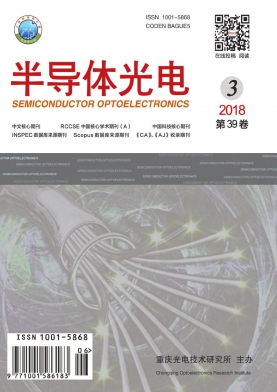有机电荷产生层对叠层磷光OLED器件性能的影响
[1] Tang C W, VanSlyke S A. Organic electroluminescent diodes[J]. Appl. Phys. Lett., 1987, 51(12): 913915.
[2] Geffroy B, Le Roy P, Prat C. Organic lightemitting diode (OLED) technology: materials, devices and display technologies[J]. Polymer International, 2006, 55(6): 572582.
[3] Wang Q, Ma D. Management of charges and excitons for highperformance white organic lightemitting diodes[J]. Chem. Society Rev., 2010, 39(7): 23872398.
[4] McCarthy M A, Liu B, Donoghue E P, et al. Lowvoltage, lowpower, organic lightemitting transistors for active matrix displays[J]. Science, 2011, 332(6029): 570573.
[5] Reineke S, Thomschke M, Lüssem B, et al. White organic lightemitting diodes: Status and perspective[J]. Rev. of Modern Phys., 2013, 85(3): 12451293.
[6] Kido J, Matsumoto T, Nakada T, et al. 27.1: Invited paper: High efficiency organic EL devices having charge generation layers[J]. Sid Symposium Digest of Technical Papers, 2003, 34(1): 964965.
[7] Kanno H, Holmes R J, Sun Y, et al. White stacked electrophosphorescent organic lightemitting devices employing MoO3 as a chargegeneration layer[J]. Adv. Mater., 2006, 18(3): 339342.
[8] Bao Q Y, Yang J P, Li Y Q, et al. Electronic structures of MoO3based charge generation layer for tandem organic lightemitting diodes[J]. Appl. Phys. Lett., 2010, 97(6): 0633030633033 .
[9] Meyer J, Krger M, Hamwi S, et al. Charge generation layers comprising transition metaloxide/organic interfaces: Electronic structure and charge generation mechanism[J]. Appl. Phys. Lett., 2010, 96(19): 1933021933023.
[10] Chen Y, Chen J, Ma D, et al. High power efficiency tandem organic lightemitting diodes based on bulk heterojunction organic bipolar charge generation layer[J]. Appl. Phys. Lett., 2011, 98(24): 2433092433093.
[11] Chen Y, Chen J, Ma D, et al. Tandem white phosphorescent organic lightemitting diodes based on interfacemodified C60/pentacene organic heterojunction as charge generation layer[J]. Appl. Phys. Lett., 2011, 99(10): 1033041033043.
[12] Gao X D, Zhou J, Xie Z T, et al. Mechanism of charge generation in ptype doped layer in the connection unit of tandemtype organic lightemitting devices[J]. Appl. Phys. Lett., 2008, 93(8): 0833040833043.
[13] Jin T C, Kim D H, Koh E I, et al. Efficiency enhancement of tandem organic lightemitting devices by a combined charge generation layer and organic ntype bis(ethylenedithio)tetrathiafulvalenedoped electron transport layer[J]. Thin Solid Films, 2014, 570: 6367.
[14] Yang J, Suman C K, Kim J, et al. Fabrication of transparent Al∶LiF composite/MoO3 interconnecting layers for tandem white organic light emitting devices[J]. J. Nanosci. Nanotechnol., 2014, 14(8): 58985902.
[15] Wu Y, Sun Y, Qin H, et al. Buffermodified n/ptype and p/ntype planar organic heterojunctions as charge generation layers for high performance tandem organic lightemitting diodes[J]. Synthetic Metals, 2017, 228: 4551.
[16] Wu Y, Sun Y, Qin H, et al. Highperformance tandem organic lightemitting diodes based on a buffermodified p/ntype planar organic heterojunction as charge generation layer[J]. Appl. Phys. A Mater. Science & Proc., 2017, 123(4): 234240.
[17] Tsutsui T, Terai M. Electric fieldassisted bipolar charge spouting in organic thinfilm diodes[J]. Appl. Phys. Lett., 2004, 84(3): 440442.
[18] Chen C W, Lu Y J, Wu C C, et al. Effective connecting architecture for tandem organic lightemitting devices[J]. Appl. Phys. Lett., 2005, 87(24): 2411212411213.
[19] Kanno H, Holmes R J, Sun Y, et al. White stacked electrophosphorescent organic lightemitting devices employing MoO3 as a chargegeneration layer[J]. Adv. Mater., 2006, 18(3): 339342.
[20] Chen P, Xue Q, Xie W, et al. Colorstable and efficient stacked white organic lightemitting devices comprising blue fluorescent and orange phosphorescent emissive units[J]. Appl. Phys. Lett., 2008, 93(15): 1535081535083.
[21] Chang C C, Chen J F, Hwang S W, et al. Highly efficient white organic electroluminescent devices based on tandem architecture[J]. Appl. Phys. Lett., 2005, 87(25): 2535012535013.
[22] Zhang H, Dai Y, Ma D, et al. High efficiency tandem organic lightemitting devices with Al/WO3/Au interconnecting layer[J]. Appl. Phys. Lett., 2007, 91(12): 1235041235043.
[23] Liao L S, Klubek K P, Tang C W. Highefficiency tandem organic lightemitting diodes[J]. Appl. Phys. Lett., 2004, 84(2): 167169.
[24] Guo F, Ma D. White organic lightemitting diodes based on tandem structures[J]. Appl. Phys. Lett., 2005, 87(17): 1735101735103.
[25] Chan M Y, Lai S L, Lau K M, et al. Influences of connecting unit architecture on the performance of tandem organic lightemitting devices[J]. Adv. Functional Mater., 2007, 17(14): 25092514.
王振, 柳菲, 郑新, 陈爱, 谢嘉凤. 有机电荷产生层对叠层磷光OLED器件性能的影响[J]. 半导体光电, 2018, 39(3): 332. WANG Zhen, LIU Fei, ZHENG Xin, CHEN Ai, XIE Jiafeng. Effect of Organic Charge Generation Layer on Optoelectronic Performance of Tandem Phosphorescent OLED[J]. Semiconductor Optoelectronics, 2018, 39(3): 332.



